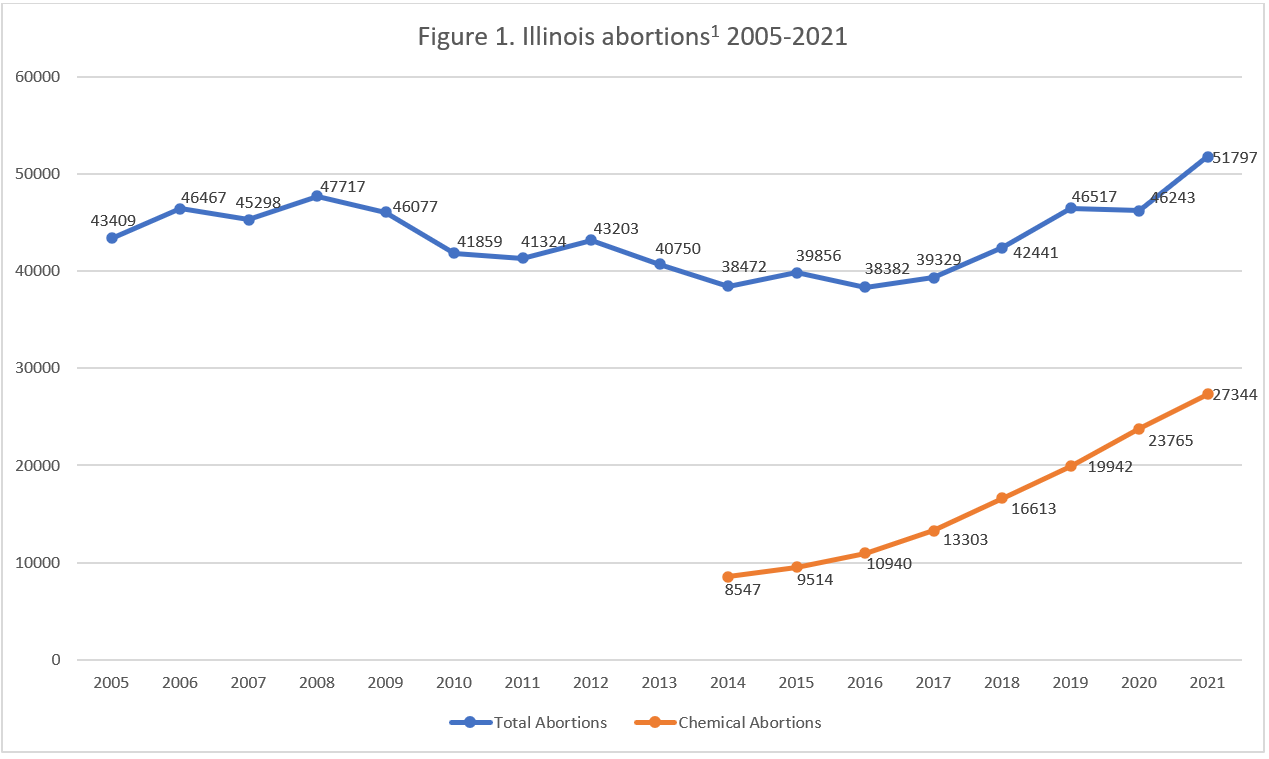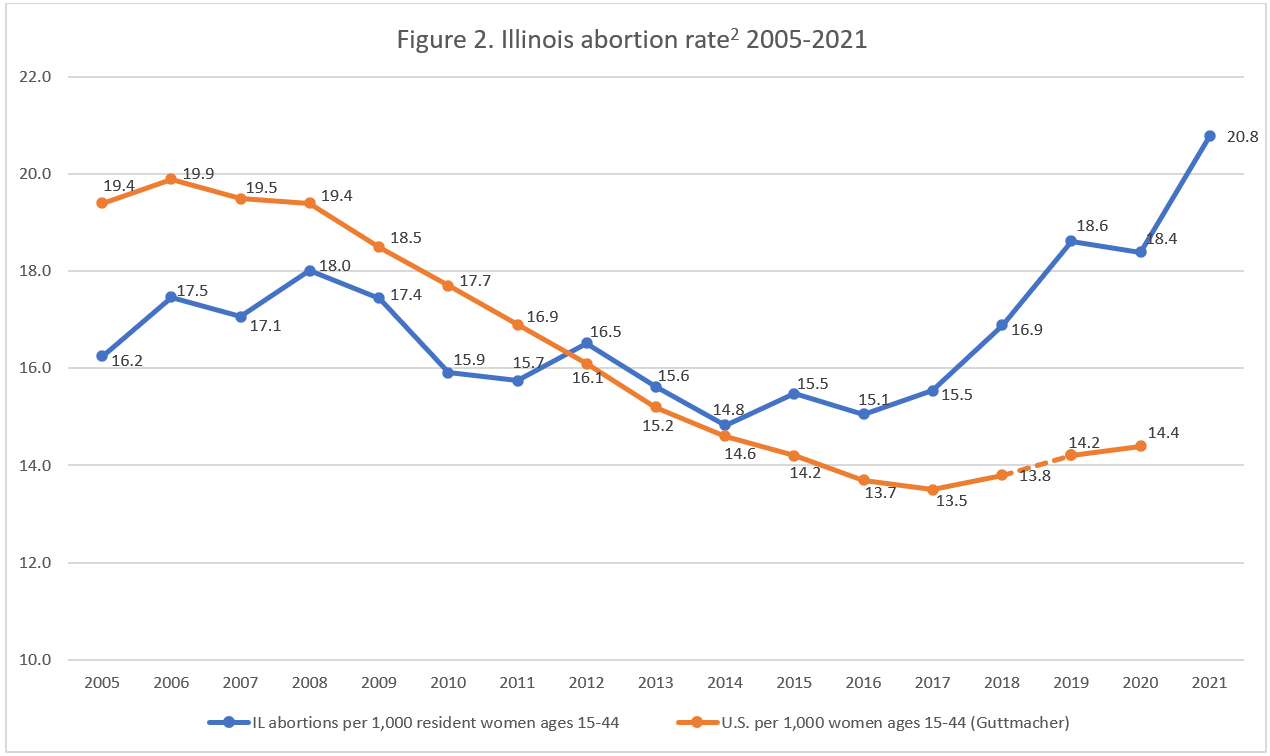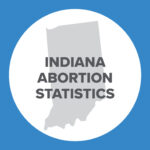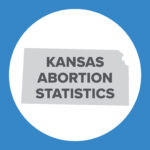Abortion Reporting: Illinois (2021)
The Illinois Department of Public Health published its 2021 abortion statistics online in June 2023.
Statistics and Changes in Illinois Abortions, 2020-2021
 The report does not include information on Planned Parenthood’s Illinois abortion market share.
The report does not include information on Planned Parenthood’s Illinois abortion market share.
Abortion Totals and Trends
Abortions in Illinois increased in 2021 by 12 percent from 2020 (Fig. 1). Chemical abortions jumped by 15 percent from 2020, making up 53 percent of the 2021 total. Charlotte Lozier Institute (CLI) estimates that Illinois’ 2021 abortion rate was 20.8 abortions per 1,000 women ages 15 to 44 (Fig. 2). As of July 2023, 32 states have released 2021 abortion statistics, with 23 states reporting increases from 2020.
State Report Summary
Seventy-seven percent of Illinois abortions were performed on state residents in 2021, while 22 percent were on women from other states. Residence was not reported for just under one percent of the abortions.
Three percent of the abortions were performed on minors. Sixty-five percent were obtained by women ages 18-29, and 29 percent were performed on women in their thirties. Three percent were performed on women in their forties or older. Age was not reported for 0.5 percent of the abortions.
Fifty-six percent of Illinois abortions occurred prior to eight weeks gestation, 29 percent between eight and 11 weeks, and seven percent between 12 and 15 weeks. Four percent of the abortions were performed at 16 weeks of gestation or later; Illinois did not report the precise gestational ages at which abortions occurred after 16 weeks. Gestational age was not reported for three percent of the abortions.
Multiple methods can be reported for each abortion, so the number of abortions reported for each type of procedure adds up to slightly more than the total number reported in Illinois. Over half the abortions occurring in Illinois in 2021 (53 percent) were chemical abortions. Surgical procedures were used for 45 percent of the abortions. However, the report did not document the specific types of surgical procedures that were used. An additional two percent of the abortions were performed using an unknown method.
Changes to Abortion Reporting Laws in Illinois
In June 2023, the Illinois Department of Public Health (IDPH) announced that it revised how it collects and reports data on state abortions “in order to protect the privacy and safety of those who receive abortions and abortion providers.” IDPH stated that the changes were made in response to the U.S. Supreme Court’s Dobbs decision in June 2022 as well as changes made to Illinois’ Reproductive Health Act in January 2023. The state continues to report aggregate data on the total number of abortions performed in Illinois, but IDPH no longer collects or reports county level data or the states from which non-Illinois residents travel to obtain abortions. Illinois also simplified how data on abortion methods is collected and reported, using only two broad categories of abortion methods— “medication,” or chemical, and “procedural,” or surgical—instead of reporting the specific types of surgical procedure performed in the state. The 2021 abortion data released by the state seems to have already been subject to these changes.
Other Legislative Changes
Following the overturn of Roe v. Wade in June 2022, abortion jurisprudence in Illinois was unaffected. The state’s law limiting abortion at viability (Ill. Rev. Stat. chg. 775 §55) contains a health exception so broad that abortions may be performed at virtually any point in pregnancy. Further undermining the viability limit, Illinois does not define viability to coincide with a specific week of gestation. Instead, “viability” is left to the judgment of the abortion provider, who has a vested interest in going forward with the abortion.
In January 2023, Illinois governor J.B. Pritzker signed an abortion omnibus bill (HB 4664). This bill shields abortion providers from legal action initiated by pro-life states and requires that insurance plans fully cover dangerous abortion pills at no cost to the woman, in addition to the surgical abortion coverage already required by the state’s Reproductive Health Act of 2019.
Because of these legislative changes and the enactment of pro-life laws in neighboring states, CLI expects that nonresident abortion totals will increase in Illinois when IDPH releases 2022 data next year. In 2020, abortion totals increased when Planned Parenthood opened an abortion mega center on the border of Missouri. The increase in Illinois abortions in 2020 was also driven by legislative changes in Missouri that regulated chemical abortion provision in the state. As a result, Missouri’s sole abortion center, Planned Parenthood of Saint Louis, started sending its patients to the mega center in 2020. However, Illinois is no longer collecting and reporting information on the states that nonresident women travel from to obtain abortions in Illinois (as mentioned above).
State Ranking
In 2016, CLI evaluated abortion reporting across the country and ranked Illinois’ reporting as tied for 13th best. Since then, the state’s abortion reporting has declined in quality, given the changes the state has made to its reporting laws in 2023. To improve its reporting, Illinois could incorporate all the information it reported in its annual reports published before 2019 and provide data on complications related to abortion procedures.


- Illinois’ 2014 abortion report was the first to include the number of chemical abortions reported in the state. Previous reports did not report chemical abortions as a separate category. The 2018 chemical abortion total has been updated to include chemical abortions performed on women of unknown residency; previous reports suppressed this number.
- National rates were obtained from the Guttmacher Institute. Illinois rates were calculated by CLI using the following formula: (total number of abortions performed in Illinois ÷ number of resident women ages 15-44) x 1,000. Rates may differ slightly from previous CLI articles due to revised population estimates. Population estimates were obtained from CDC WONDER.




























